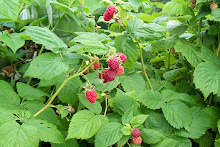 I've grown potatoes before but had given it up because the potato bugs had a field day and ate the plants all up. My neighbour grows potatoes and I asked him what he did about the bugs, he said he picked them off one by one. I tried that. It didn't work for me at all because A) The bugs make the most disgusting crunchy sound when picked and squashed and B) I really don't have 3 hours plus a day to be picking off bugs because as sure as the sun shines, I can pick 'em off in the morning and by lunch time a whole new crew has moved in and started another munch-in. I decided that my neighbour most likely just sent all his bugs over to my garden.
I've grown potatoes before but had given it up because the potato bugs had a field day and ate the plants all up. My neighbour grows potatoes and I asked him what he did about the bugs, he said he picked them off one by one. I tried that. It didn't work for me at all because A) The bugs make the most disgusting crunchy sound when picked and squashed and B) I really don't have 3 hours plus a day to be picking off bugs because as sure as the sun shines, I can pick 'em off in the morning and by lunch time a whole new crew has moved in and started another munch-in. I decided that my neighbour most likely just sent all his bugs over to my garden.
I was disappointed that I didn't have potatoes because the first year was so great. I never really considered growing potatoes; I live on Prince Edward Island and potatoes are plentiful and cheap (until lately). But I was visiting a friend and she asked me if I would like some russet potato sets for my garden. I love red potatoes! As she blithely cut sets for me, I started asking questions. How deep do I plant them? How far apart? Do I plant them skin side up or down? How high should the rows be? Should they be watered daily until I see sprouts? Do they need a lot of water or are they a little drought resistant? She handed me a paper bag full of potato cuttings and said, "Would you please stop micro-managing? Dig a trench, throw them in, cover 'em up, get on with your life." So I did and I got beautiful potatoes. That was the first and last time I ever had any success with taters. The next year the bugs found my potatoes.
I'm hoping my luck will change this year. Another friend of my told me about the tire method of growing potatoes. So I'm going to try that. The theory is great, makes a lot a sense so naturally I'm suspicious of it. If there's one thing I've learnt in my gardening adventures it's everything is fine in theory, it's the nuts and bolts of the operation that messes everything up. And I always seem to have extra nuts hanging around. The process is simple, you get an old tire fill it with earth/compost/worm castings, stick a few potatoes in it and there you go. As the stalks get high enough, you put another tire on top of the first one and fill it again until only a little bit of the stalks are showing. The theory is the stalk you covered up with earth will start sending out roots and make more potatoes. That makes sense to me. Whenever I start new indoor plants from cuttings, I take off a few bottom leaves and roots will start growing where the leaves used to be. If I leave the leaves on, roots sprout around them. Apparently you can stack the tires 4 deep, and each tire supposedly gives 25 pounds of potatoes.
So I tried it this year and after a couple of teeny tiny little errors (ya notice theory never takes into account the intelligence of the person implementing the theory?), things seem to be coming up roses, or in this case, potatoes. I bought organic red potatoes from the grocery store, cut up a couple and put 8 pieces in the tire and covered them up. I found out, 3 pieces is usually the amount planted in a tire. Ooops. Two week later, I don't have one sprout. No little leafy taters starting up at all. So my neighbour gave me a few of his extras. He said the potatoes I used were probably sprayed with something to stop them from sprouting. Ew. So I planted 4 more and sure enough, the next day the first potatoes I planted make an unexpected appearance. Methinks I planted 'em to deep. Oh well, never mind, I have them growing and they seem to be doing well. The best thing is no bugs so far. I doubt if I will get to 4 tires high because I was late in planting them but I'm interested in seeing if this actually works. I do have some extra tires waiting just in case I need them.





 days letting the tomatoes ferment. Apparently knowing the seeds are ready is easy, you just wait for a disgusting, scummy, smelly, slimy layer form on the top of the water. It also attracts those horrible little fruit fly things and haunt me this time of year. So here they are, all scummed up and ready for the next step.
days letting the tomatoes ferment. Apparently knowing the seeds are ready is easy, you just wait for a disgusting, scummy, smelly, slimy layer form on the top of the water. It also attracts those horrible little fruit fly things and haunt me this time of year. So here they are, all scummed up and ready for the next step.
































 I
I




